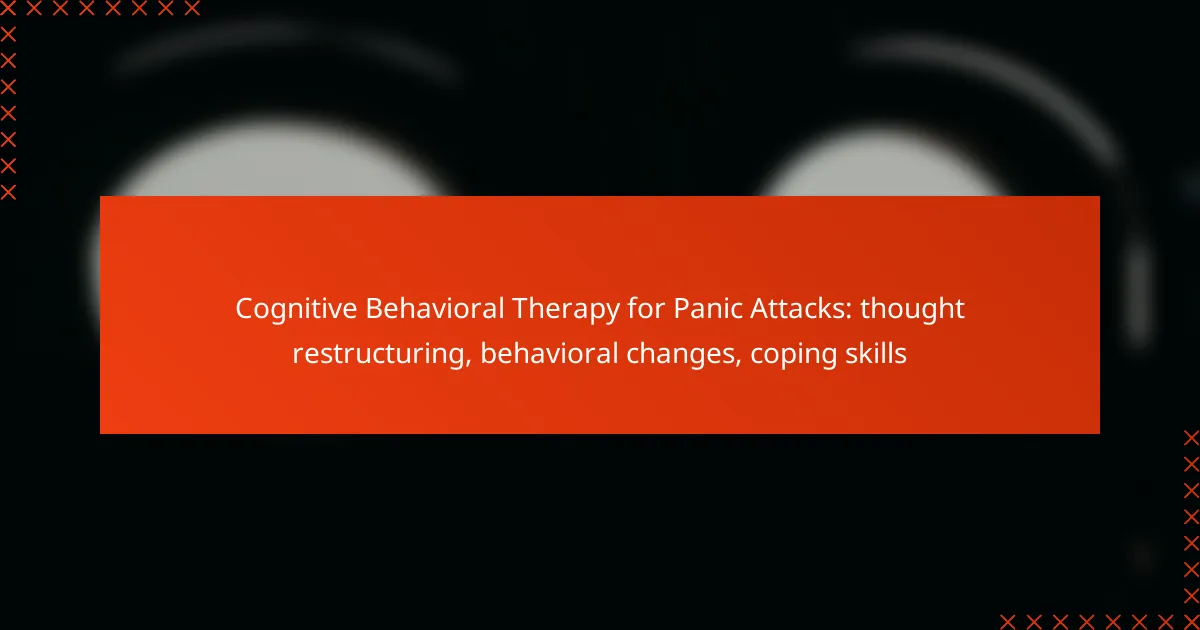Cognitive Behavioral Therapy (CBT) is a powerful approach for managing panic attacks, focusing on thought restructuring, behavioral changes, and the development of coping skills. By helping individuals identify and alter negative thought patterns, CBT promotes positive behaviors and equips them with practical strategies to effectively manage anxiety and panic symptoms.
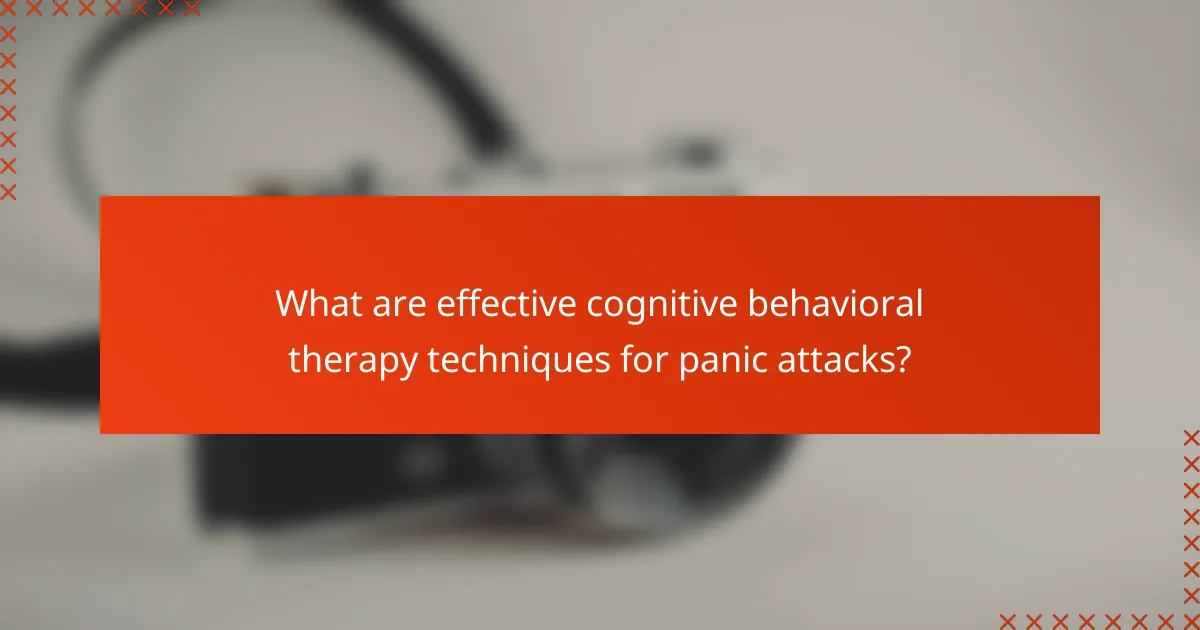
What are effective cognitive behavioral therapy techniques for panic attacks?
Effective cognitive behavioral therapy (CBT) techniques for panic attacks include thought restructuring, behavioral activation, and coping skills training. These methods help individuals identify and modify negative thought patterns, engage in positive behaviors, and develop practical strategies to manage anxiety and panic symptoms.
Thought restructuring
Thought restructuring involves identifying and challenging distorted thoughts that contribute to panic attacks. This technique encourages individuals to recognize negative beliefs, such as “I will lose control,” and replace them with more balanced thoughts, like “I can handle this situation.” Practicing this skill can significantly reduce anxiety levels over time.
To implement thought restructuring, keep a thought diary to track panic-related thoughts and the emotions they evoke. Over time, this can help you identify patterns and develop healthier cognitive responses. Remember to be patient; changing thought patterns takes practice.
Behavioral activation
Behavioral activation focuses on increasing engagement in positive activities to counteract feelings of anxiety and depression. By scheduling enjoyable or meaningful tasks, individuals can create a sense of accomplishment and reduce avoidance behaviors that often accompany panic attacks. This technique emphasizes the importance of action in improving mood and reducing panic symptoms.
Begin by listing activities you enjoy or find fulfilling, and set specific times to engage in them. Aim for a mix of social, physical, and relaxing activities. Avoid overwhelming yourself; start with small, manageable tasks and gradually increase your involvement as you feel more comfortable.
Coping skills training
Coping skills training equips individuals with practical strategies to manage panic attacks when they occur. This may include deep breathing exercises, mindfulness techniques, and grounding exercises that help redirect focus during a panic episode. Learning these skills can empower individuals to take control of their reactions to anxiety.
Consider practicing deep breathing by inhaling slowly through your nose for a count of four, holding for four, and exhaling through your mouth for a count of four. Regular practice can make these techniques more effective during a panic attack. Additionally, create a personalized coping skills toolkit with your favorite strategies for quick access when needed.
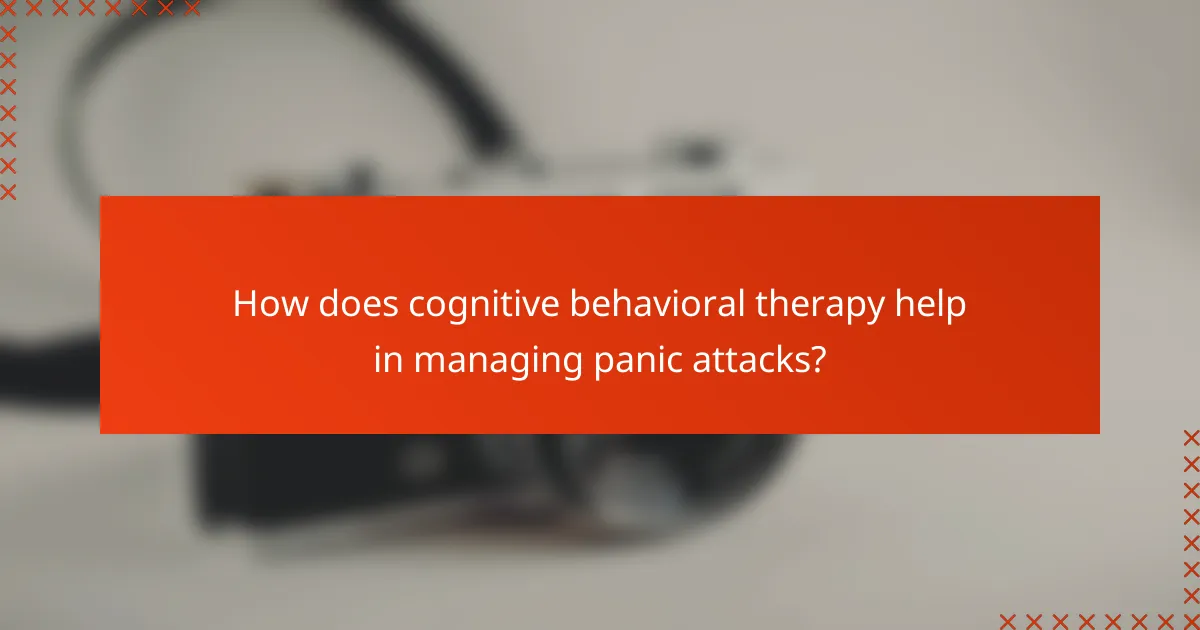
How does cognitive behavioral therapy help in managing panic attacks?
Cognitive Behavioral Therapy (CBT) is effective in managing panic attacks by addressing negative thought patterns and promoting behavioral changes. It helps individuals understand the connection between their thoughts, feelings, and behaviors, leading to reduced panic symptoms and improved coping strategies.
Reduces anxiety symptoms
CBT helps reduce anxiety symptoms by teaching individuals to identify and challenge irrational thoughts that contribute to panic. By restructuring these thoughts, patients can diminish the intensity of their anxiety and lessen the frequency of panic attacks.
Techniques such as exposure therapy can also be incorporated, where individuals gradually face feared situations in a controlled manner, helping to desensitize them to triggers and reduce overall anxiety levels.
Improves emotional regulation
Through CBT, individuals learn to better regulate their emotions by recognizing and modifying their emotional responses to stressors. This improved emotional regulation allows for a more balanced reaction to anxiety-provoking situations.
Practicing mindfulness and relaxation techniques within CBT can further enhance emotional control, enabling individuals to manage their feelings more effectively during moments of panic.
Enhances coping mechanisms
CBT equips individuals with practical coping skills to handle panic attacks when they occur. These skills include deep breathing exercises, grounding techniques, and positive self-talk, which can be employed in real-time to mitigate panic symptoms.
Additionally, developing a personalized coping plan can empower individuals to respond proactively to triggers, reducing the likelihood of panic attacks and fostering a sense of control over their anxiety.
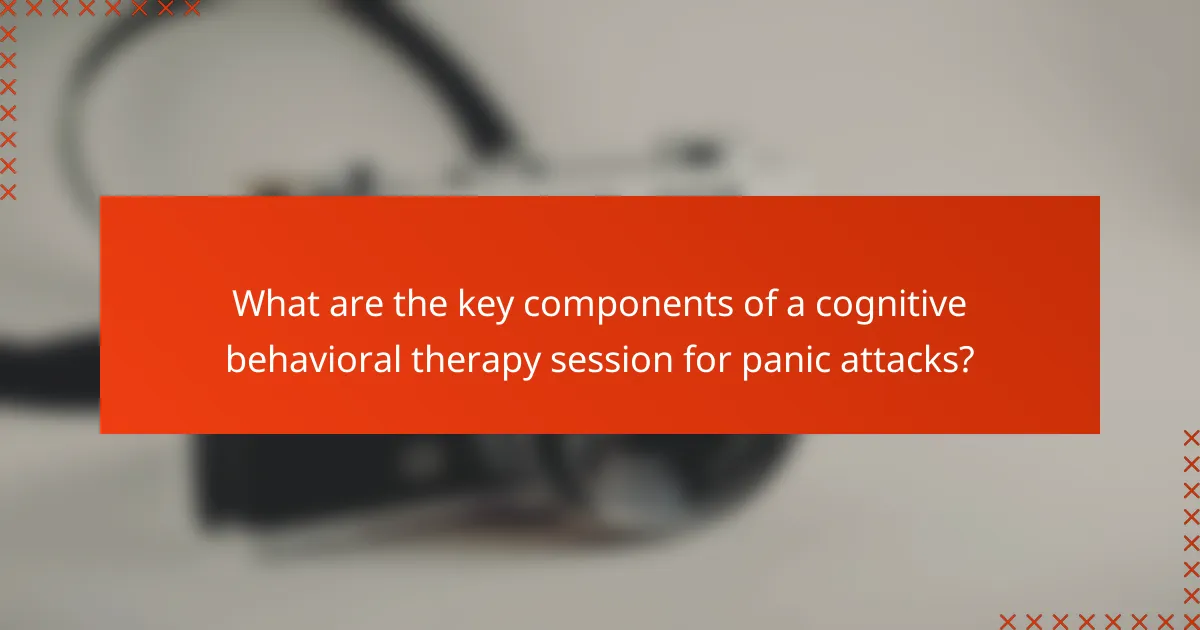
What are the key components of a cognitive behavioral therapy session for panic attacks?
A cognitive behavioral therapy (CBT) session for panic attacks typically involves assessing symptoms, setting goals, and practicing coping skills. These components work together to help individuals understand and manage their panic attacks effectively.
Assessment of symptoms
The assessment of symptoms is crucial in identifying the specific triggers and patterns associated with panic attacks. This may involve discussing the frequency, intensity, and context of the attacks, as well as any accompanying thoughts or feelings.
Therapists often use standardized questionnaires or self-report tools to gauge the severity of symptoms. Understanding these details allows for a tailored approach in subsequent sessions.
Goal setting
Goal setting in CBT focuses on establishing clear, achievable objectives related to managing panic attacks. Goals may include reducing the frequency of attacks, learning to cope with anxiety, or facing feared situations gradually.
Setting SMART goals—Specific, Measurable, Achievable, Relevant, and Time-bound—can enhance motivation and provide a roadmap for progress. For example, a goal might be to practice deep breathing techniques three times a week.
Skill practice
Skill practice involves applying coping strategies learned during therapy sessions to real-life situations. This can include techniques such as thought restructuring, where individuals challenge negative thoughts that contribute to panic.
Role-playing scenarios or using exposure exercises can help reinforce these skills. Regular practice is essential for building confidence and reducing the likelihood of future panic attacks.

What are the prerequisites for starting cognitive behavioral therapy for panic attacks?
Before beginning cognitive behavioral therapy (CBT) for panic attacks, individuals should be prepared to engage actively in the therapeutic process and have a basic understanding of panic disorder. This preparation helps facilitate effective treatment and encourages a proactive approach to managing symptoms.
Commitment to the process
Commitment is essential for successful outcomes in CBT for panic attacks. Patients need to be willing to attend sessions regularly, complete homework assignments, and practice skills learned during therapy. This dedication can significantly enhance the effectiveness of the treatment.
To maintain commitment, setting realistic goals and tracking progress can be beneficial. For example, aiming to reduce the frequency of panic attacks over a few months can provide motivation and a sense of achievement as improvements are noticed.
Understanding of panic disorder
A solid understanding of panic disorder is crucial for individuals starting CBT. This includes recognizing the nature of panic attacks, their triggers, and the physiological responses involved. Knowledge about how thoughts and behaviors contribute to panic can empower individuals to engage more fully in the therapeutic process.
Learning about common symptoms, such as rapid heartbeat, sweating, or feelings of impending doom, can help individuals identify their experiences and differentiate between panic attacks and other conditions. This understanding can also reduce fear and anxiety associated with the attacks themselves, making it easier to apply coping strategies learned in therapy.
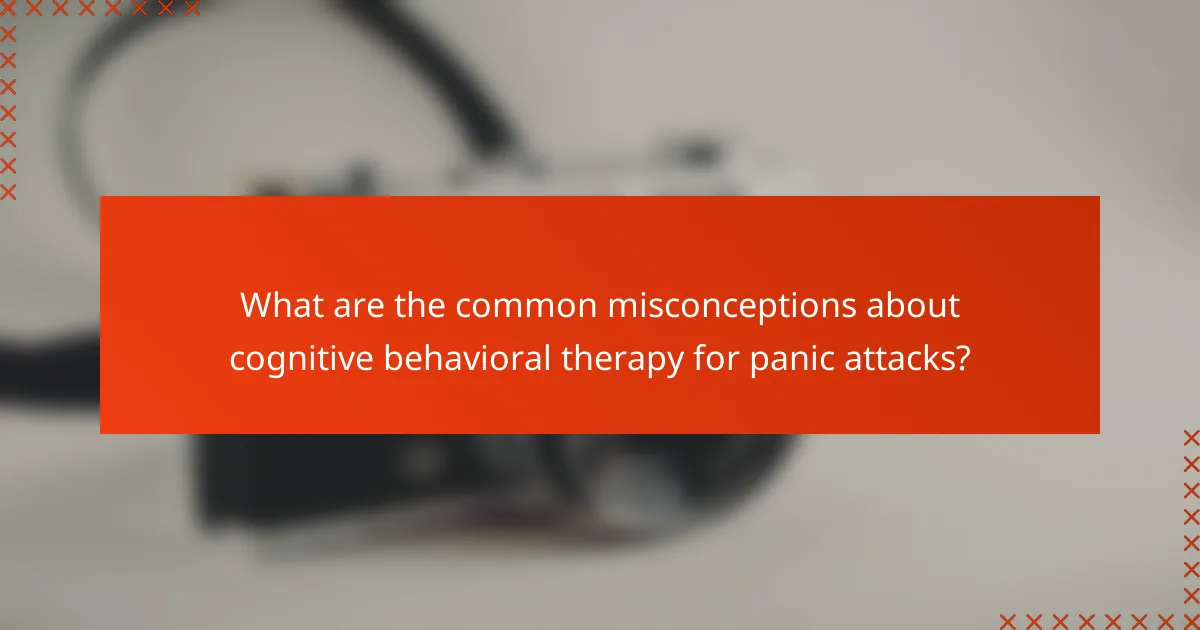
What are the common misconceptions about cognitive behavioral therapy for panic attacks?
Many people misunderstand cognitive behavioral therapy (CBT) for panic attacks, believing it to be a quick solution or only necessary for severe cases. In reality, CBT is a structured approach that requires time and effort to effectively address panic symptoms through thought restructuring, behavioral changes, and coping skills.
It’s a quick fix
A common misconception is that CBT provides immediate relief from panic attacks. While some individuals may experience quick improvements, lasting change typically requires consistent practice over weeks or months. The process involves learning to identify and challenge negative thought patterns, which takes time to master.
Effective CBT often includes homework assignments and regular sessions with a therapist, allowing individuals to gradually apply new skills in real-life situations. This commitment is essential for achieving long-term benefits and reducing the frequency of panic attacks.
Only for severe cases
Another misconception is that CBT is only suitable for individuals with severe panic disorders. In fact, CBT can be beneficial for anyone experiencing panic attacks, regardless of severity. Early intervention with CBT can help prevent the escalation of symptoms and improve overall mental health.
Individuals with mild to moderate panic symptoms can also gain valuable coping strategies and skills through CBT, enhancing their ability to manage anxiety. Seeking therapy sooner rather than later can lead to more effective outcomes and a better quality of life.
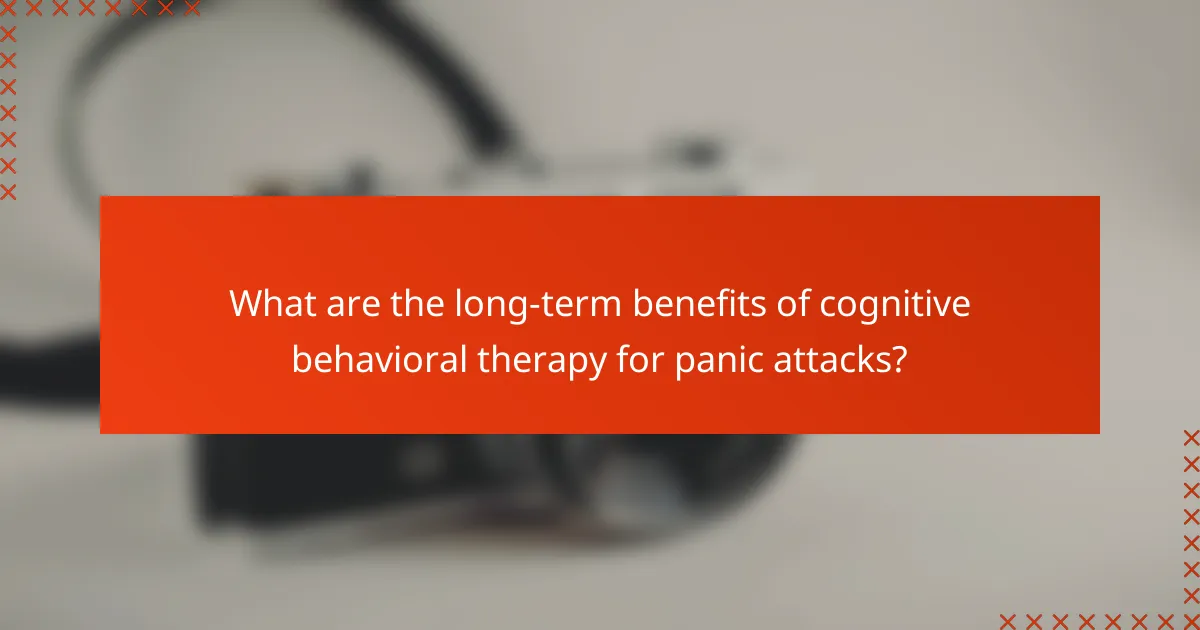
What are the long-term benefits of cognitive behavioral therapy for panic attacks?
Cognitive Behavioral Therapy (CBT) offers significant long-term benefits for individuals experiencing panic attacks, primarily by equipping them with effective coping strategies and thought restructuring techniques. These benefits include a reduction in the frequency of panic attacks and an overall increase in emotional resilience.
Reduced recurrence of panic attacks
One of the primary advantages of CBT is its ability to reduce the recurrence of panic attacks. Through techniques such as cognitive restructuring, individuals learn to identify and challenge irrational thoughts that trigger panic. This process can lead to a significant decrease in the frequency and intensity of panic episodes over time.
Additionally, CBT encourages exposure to feared situations in a controlled manner, helping individuals gradually desensitize themselves to triggers. This method can be particularly effective, as it allows for a more confident approach to situations that previously induced anxiety.
Increased resilience
CBT fosters increased resilience by teaching individuals how to manage stress and anxiety more effectively. By developing coping skills, such as mindfulness and relaxation techniques, individuals can better handle stressful situations without resorting to panic. This newfound resilience can enhance overall well-being and improve quality of life.
Furthermore, as individuals practice these coping strategies, they often find themselves better equipped to face future challenges. This proactive approach not only reduces the likelihood of panic attacks but also promotes a more positive outlook on life, contributing to long-term mental health stability.
